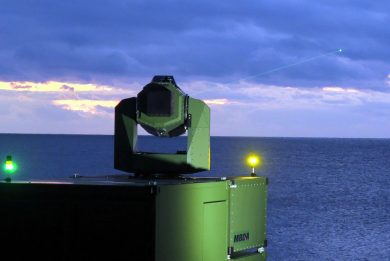
Defending from drones? Elementary Watson!
A problem in the military arena, that of UAS used as intruders in sensible areas is also a major issue in the security world, targets of any type being at the mercy of criminal organisations. These range from prisons, where UAS can be used to drop cell phones, weapons or other prohibited items that might be used for escapes or revolts, to huge gathering of people, stadiums, concerts, where these flying assets can be used to generate chaos by dropping dangerous materiel, explosive or chemicals i.e., to key infrastructures, such as nuclear power plants, dams or other. Not to mention airports, the effect of the appearance of drones around London Gatwick airport being known to all.
Italy’s CPM Elettronica portfolio includes numerous anti-drone jammers, some of the manportable (click here for more information). The Rome-based company chose Milipol Paris to unveil its latest product, the CPM Watson.
The new systems has a look similar to that of the CPM Wilson, but instead of being pistol-like it is rifle-like, being much more powerful, the stock contains one BT2590 Li-Ion rechargeable battery. Compared to the Wilson, the Watson operates on four bands, and with a much higher output. The most visible addition is that of a wideband directional antenna at the front which, together with the stock, brings the length of the system to 1,085 mm; that antenna emits on the 433, 868 and 902 MHz bands, those used for wireless connections, with an output power of 30 W in TDM (Time Division Mode). To jam remote controls two frequencies are used, 2.4 and 5.8 GHz, the two coax helix antennas being in the front part of the system body, emitting power being respectively 30 and 15 W. Last but not least the fn Yagi antenna, located on the right of the body in a small fairing, ensures the jamming of satellite telephones and global navigation satellite systems, its emitting power being of 2 W.
Based on direct modulation over digital synthesized signal technology, the CPM Watson jams in continuous wave full band digital sweep and digital noise modes. When used at full power the autonomy of the system is of around one hour, while on stand-by it can last up to 20 hours. Considering a Watson-UAS versus UAS-GCS ration of 10:1, CPM makes always clear that jamming distance depends very much on the distance between the drone and its ground control station, the higher the latter the easier the jamming, the effective blocking range of the CPM Watson is of over 1 km.
Comparing the performances with those of the CPM DJI-120-4B developed a few years ago, which was made of a backpack containing electronics linked by a cable to the rifle-like antenna carrier, the CPM Watson has a higher range, with a weight saving of 8 kg over 17 kg, the advantage of being a one-piece system rather than a two-piece one, and guarantees a similar endurance. This result is mainly due to newly designed exciter boards and amplifiers, which allow the Watson to operate on up to 15 bands (in hopping mode) while using only 4 amplifiers with a much smaller size compared to the previous generation.
It is thus quite probable that the new system will replace the existing one in the company catalogue, providing a new, lighter and more effective tool both to police and military forces.


